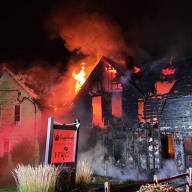On September 29, Harwood Unified Union School District (HUUSD) superintendent Dr. Mike Leichliter and director of student support services Jon Berliner sat down with The Valley Reporter and the Waterbury Roundabout to discuss the district’s use of restraint and seclusion. In particular, prone restraint and seclusion have gotten attention in the district over the last several months, as community members have pointed to data from the last several years showing Brookside Primary School in Waterbury reporting some of the highest usage in the state.
The district created a task force to address the use of these interventions in HUUSD schools and will present a preliminary report on those findings in January. A subcommittee of the HUUSD Board is also being formed to address the district’s policy on all forms of restraint and seclusion.
LEAST RESTRICTIVE
“We have a mandate to provide the least restrictive environment” for students, Berliner said. “The idea of least restrictive environment, generally speaking, is you want a student to be in the classroom with their same-age peers as much as possible. For students who sometimes exhibit challenging behaviors, a decision is made to provide an adult to support them individually. When the behaviors can pose safety challenges to either the student and/or others in the school oftentimes we use a behavior interventionist (BI),” which includes outside providers such as Washington County Mental Health and Green Mountain Behavior Consulting.
“The students in the past who have been restrained have been students who it’s part of their plan, they have BIs in most cases. There are significant behaviors,” Leichliter said. He and Berliner said it’s typically a small group of students who need these preventions in HUUSD schools.
“The way it works in Vermont in general and in this school district is if there’s a student who is having challenging behaviors, there’s a few different tracks to go down. In the case of Brookside, those students all had individual education plans (IEPs). They were identified as students who needed support that was outside of the realm of the general education setting,” Berliner said. “In consultation with the IEP team and the outside providers, they create a support plan for a student and possibly a crisis plan, if there’s reason to believe that that could be needed.” The HUUSD uses Crisis Prevention Institute (CPI) training for staff.
RULE 4500
Vermont Agency of Education (AOE) “Rule 4500 (which governs restraint and seclusion) permits in certain situations the use of restraint or seclusion,” Berliner said. “Before the pandemic the AOE’s guidance was the least restrictive because it allowed a person to be close to the student to keep safe, to be able monitor to make sure the student was OK. During the pandemic the AOE’s guidance changed.”
The AOE issued new guidance prohibiting staff from touching students because of health and safety concerns. That guidance advised seclusion when students’ behavior escalated.
All schools in the HUUSD have a designated area for seclusion. Rule 4500 states, “Seclusion means the confinement of a student alone in a room or area from which the student is prevented or reasonably believes he or she will be prevented from leaving. Seclusion does not include time-out where a student is not left alone and is under adult supervision.” There are some situations where students are in such rooms with a BI or other adult. Seclusion rooms may feature soft furnishings to keep students safe.
DE-ESCALATE
“The way rule 4500 works and the way that’s best practice is you want to try to de-escalate a situation verbally [first]. All the trainings these BIs and special educators do emphasize that,” Berliner said. “Those trainings are about verbal de-escalation, situational de-escalation, finding a place if there’s sensory overload in a classroom, finding different options” based on students’ individual needs. “Some students need to be outside because fresh air and openness makes them de-escalate. Some students need really limited sensory input that even outside is too much. So, you want to find a space that provides what the team has determined is the most likely to help de-escalate them to prevent unsafe behaviors.
“The word that’s used is ‘antecedent,’ what things in their environment can be changed or how you help try to can minimize [escalation]. That’s always, always first,” Berliner said. “Seclusion or restraint are only used when it’s been determined that there is an imminent safety issue, either to the student themselves or to others. Part of these IEPs and support plans involve direct instruction to help teach the students to learn about their own antecedents that may escalate them and to proactively practice strategies that help them de-escalate themselves,” Berliner said, which he called an ongoing process. He noted that a common example of such a strategy is breathing.
“It’s scary for a lot of students who are feeling out of control. Oftentimes the student is the most confused person in the situation. They don’t understand what’s happening inside of them, why they’re doing that,” Berliner said. “I believe students want to learn. They want to be in their classroom. When they can’t, it’s scarier for them than almost anybody else. Teaching them that piece as part of a proactive strategy is a really important part,” he added.
“What we’re doing with the group I’ve assembled of administrators is we’re first talking internally — we have someone from middle school, elementary, and high school.” Last week consultant Dyane Lewis Carrere, author of “The Re-Set Process: Trauma-Informed Behavior Strategies,” visited the district. “We’re going to work with her on an ongoing basis this year,” Leichliter said. “Her book and her approach is ‘how do you look individually at a student’ and ‘how do you work as an institution?’ She looked at ‘how we are using restraint and seclusion and how are we using therapeutic spaces, what do they look like, what’s a different process’? It’s important to have somebody who’s a credentialed, recognized expert with muti-state experience, including experience working in Vermont, to come in and give us a different perspective and training,” Leichliter said. “It’s very complex,” Berliner added.
“Your goal is always to have students who are well-regulated in school who feel they have a sense of belonging, who are functioning well, teachers who are well-trained who feel comfortable,” Leichliter said. “This is going to take work and effort and agreement of people coming together. I think we’re on the right process.”












